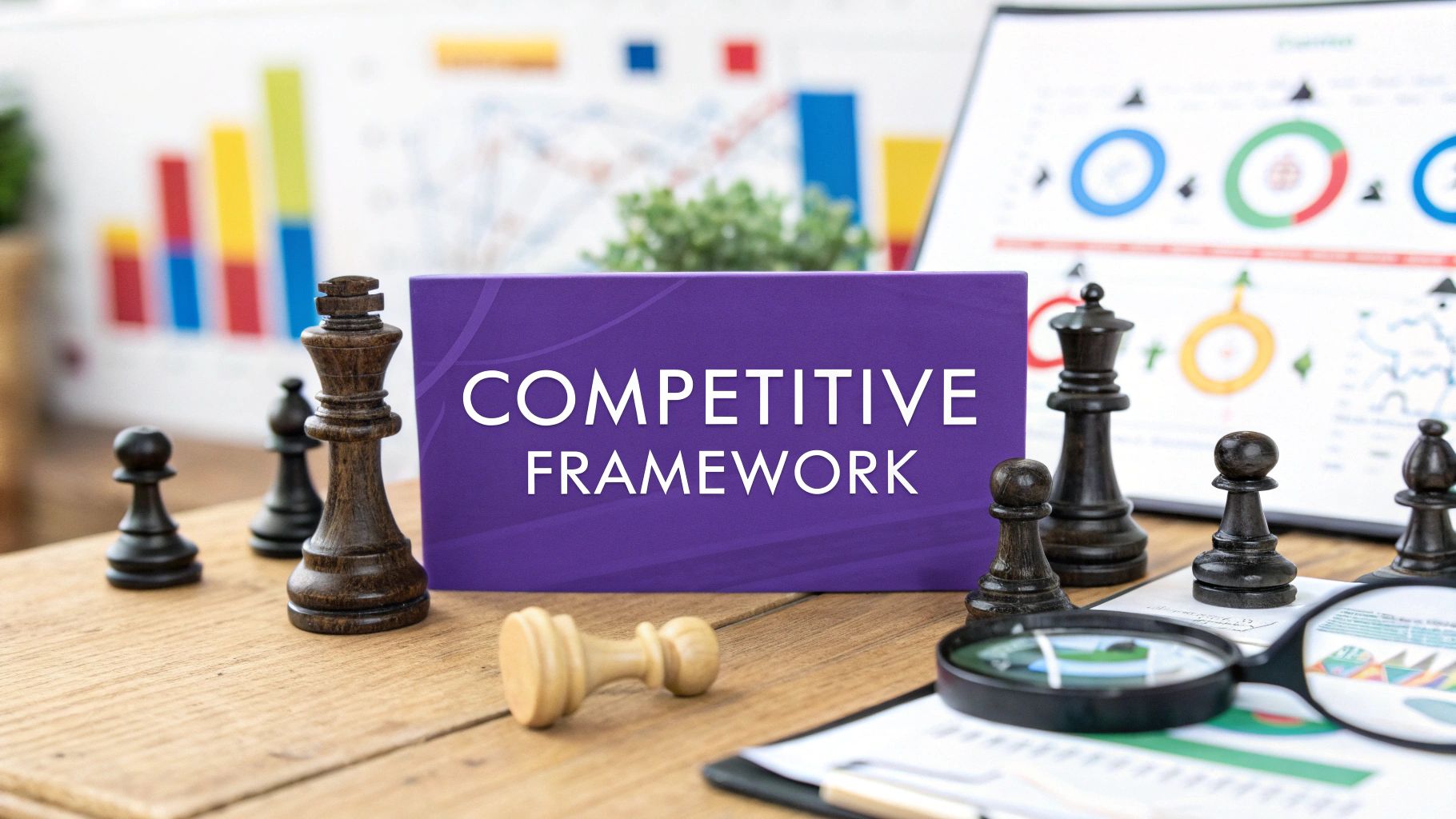Master Your Strategy with a Framework of Competitive Analysis
Learn how to create a strong framework of competitive analysis to identify opportunities and stay ahead in your market. Start winning today!

So, what exactly is a competitive analysis framework? Think of it less as a stuffy business school term and more as a repeatable playbook. It’s a structured system you can rely on to identify your rivals, figure out what they're up to, and turn that knowledge into a real-world advantage. This isn't about occasionally peeking at what the other guys are doing; it’s about having a game plan.
Decoding the Competitive Playbook
Imagine trying to win a championship game without studying the other team's star players or their signature moves. You'd be stuck reacting to everything they do, always a step behind. A good competitive analysis framework is like getting your hands on their entire playbook before the opening whistle. It gives you the structure to stop being reactive and start being proactive.
Without a system, competitor research is just… chaos. You might grab a few random data points—a new blog post from one competitor, a pricing change from another—but you'll have no idea how it all fits together. A framework brings order to that mess. It makes sure you’re gathering the right intel, looking at it consistently, and using it to make genuinely smart decisions.
Why a Systematic Approach Wins
Wingin' it with your analysis is a surefire way to develop blind spots and miss golden opportunities. A structured framework, on the other hand, helps you build a complete, 360-degree view of your market. This isn’t just a luxury for massive corporations anymore; it’s a must-have for any business that wants to carve out and protect its piece of the pie. The numbers don't lie.
> The global market for competitor analysis was valued at around $4.3 billion USD in 2021 and is on track to hit $6.6 billion USD by 2025. That’s a jump of about 53% in just four years, all because businesses need strategic clarity to navigate a ridiculously fast-paced economy. You can dig into the details in the full competitor analysis market report.
A solid framework helps you nail a few goals that are absolutely critical for growth. To put it simply, a structured approach helps you achieve what ad-hoc research can't.
Here's a quick look at what a good framework brings to the table.
What a Competitive Analysis Framework Delivers
| Goal | Why It Matters for Your Business | | :--- | :--- | | Identify Your Real Threats | Forces you to look past the obvious players and spot the indirect or new competitors who could blindside you. | | Pinpoint Market Gaps | By comparing what's out there, you can find unmet customer needs that your business is uniquely suited to solve. | | Refine Your Value Proposition | Understanding how others pitch themselves helps you sharpen your own message and double down on what truly makes you different. | | Anticipate Market Shifts | Consistent analysis lets you spot trends early—from new pricing models to emerging tech—so you're never caught flat-footed. |
Ultimately, having a framework of competitive analysis turns research from a boring data-gathering chore into a powerful strategic weapon. It’s all about creating a repeatable process that gives you the confidence to make bold moves and stay ahead of the pack.
How to Identify Your True Competitors

Before you can even think about building a solid framework of competitive analysis, you have to know who you’re really up against. This sounds obvious, right? But the reality is, your competitive world is almost always bigger and way more complicated than it looks on the surface. Too many businesses get tunnel vision, only watching their most obvious rivals, and end up blindsided by threats they never saw coming.
To dodge that bullet, you have to think bigger. Let’s use a simple analogy: a local coffee shop. The café directly across the street is a direct competitor. But what about the juice bar next door? They’re an indirect competitor—they both solve the "I need a refreshing morning drink" problem, just in different ways. And don't forget the new breakfast spot opening down the block next month; they’re an emerging competitor who could easily start pulling your customers away.
Your business is no different. To get the full picture, you need to identify and sort every player trying to win over your audience.
Mapping Your Competitive Universe
A truly great analysis begins with categorizing your competitors. This simple step immediately cuts through the noise and helps you figure out where to focus your energy. The goal isn't just to make a list of names; it's to create a strategic map of your entire market.
You can usually slot competitors into three main buckets:
- Direct Competitors: These are the ones you think of first. They offer a very similar product or service to the exact same people you're trying to reach. When a customer is ready to buy, it's often a toss-up between you and them.
- Indirect Competitors: These companies solve the same core problem for your customers, but they do it with a totally different solution. They might not sell the same thing, but they’re absolutely fighting for the same slice of your customer's wallet.
- Emerging Competitors: Think of these as the wild cards. They could be scrappy startups with a fresh idea or established companies in a nearby industry who realize they could easily move into your turf.
> Identifying these different competitor types is the first step toward building a resilient strategy. Marketing experts often point out a common mistake: businesses get obsessed with the big, aspirational brands while completely missing the smaller, hungrier upstarts who are quietly stealing their audience.
By mapping all three types, you get a 360-degree view that eliminates blind spots. This ensures your framework of competitive analysis is built on what's actually happening in the market—not just what you think is happening—so you can be proactive instead of just reactive.
Building the Pillars of Your Framework
So, you’ve identified your key competitors. Great. Now for the real work: figuring out what to actually look at. A truly powerful framework of competitive analysis isn't about collecting random facts and figures. It’s about building a structured approach around specific, measurable pillars that give you a 360-degree view of their business. Without a solid structure, you’re just gathering trivia.
Think of it like a mechanic inspecting a car. They don’t just wander around and kick the tires. They have a detailed checklist—engine, brakes, transmission, electrical systems. Each pillar of your framework is like one of those systems, making sure you get a thorough and genuinely insightful analysis every single time.
The Four Core Pillars of Analysis
To keep your research focused and prevent you from going down endless rabbit holes, it's best to break it down into four core pillars. This approach makes sure you hit all the critical parts of a competitor's strategy, from what customers see on the surface to what’s happening behind the scenes.
These pillars are:
- Products & Pricing: This is their core offer. You’ll dig into their product features, assess the quality, and figure out how their pricing model is structured. Are they positioning themselves as the high-end, premium choice or the go-to budget option?
- Marketing & Sales: This covers how they get attention and turn prospects into paying customers. You'll investigate their go-to marketing channels, the messaging that resonates with their audience, and the sales funnels they've built.
- Brand & Reputation: This pillar is all about how they’re perceived in the wild. It means diving into customer reviews, judging the quality of their support, and getting a feel for the overall sentiment surrounding their brand.
- Operations & Growth: This gives you a peek behind the curtain. Look at their company size, any funding they’ve raised, and key hires that might signal their next big move.
By systematically working through each of these areas, you get past surface-level observations and start understanding the why behind what your competitors are doing. You can reverse-engineer their content strategy, spot weak points in their customer journey, and maybe even predict their next product launch.
A huge part of this is evaluating key performance metrics to see how they stack up. This means tracking things like market share, customer sentiment, and of course, product quality and pricing. To do this right, you’ll lean on tools like Google Analytics, SEMrush, and Sprout Social to monitor everything from website traffic and SEO performance to social media engagement. If you want to go deeper, you can discover more about using key metrics in competitive analysis to make your framework even more robust.
This infographic does a great job of breaking down the kinds of data you'll be pulling together.

As you can see, the data comes from all over the place—from website stats to social media metrics—and it all feeds into creating that complete picture.
Turning Questions Into Insights
For each of these pillars, the real magic happens when you start asking pointed questions. Don't just make a note that a competitor has a blog. Instead, ask how that blog actually helps their sales process. This simple shift is what turns basic data collection into strategic intelligence, and it’s the true foundation of your competitive analysis framework. A repeatable checklist of these kinds of questions is what ensures your analysis is sharp and useful every time.
2. Essential Tools for Gathering Competitor Data

In any competitive analysis framework, information is everything. But the real trick isn't just finding information; it's finding the right information without drowning in a sea of data. You need to build a modern toolkit that gathers intel efficiently. Think of it as upgrading from an old, dusty library to a set of high-tech research gadgets.
This means pulling together a smart mix of powerful, accessible tools that give you insights in near real-time. The days of poring over quarterly reports are long gone—the market just moves too fast. Modern analysis relies on automated data collection, like web scraping and AI-driven analytics. The global business intelligence market, which is full of these tools, is expected to reach $78.42 billion USD by 2032. It's a huge shift, and you can learn more about the growth of modern BI tools and why they matter.
Building Your Digital Toolkit
Your toolkit doesn't have to break the bank or be overly complex. The goal is to cover the three main pillars of your analysis—marketing, product, and brand perception—with solid data.
A fantastic place to start is with SEO and content analysis tools. Platforms like Semrush or Ahrefs are absolute must-haves here. They’re like putting on X-ray goggles and looking at your competitor's entire online strategy. With them, you can instantly see:
- Top Organic Keywords: Pinpoint the exact search terms they rank for, which tells you all about their content focus and who they're trying to reach.
- Backlink Profile: Discover who is linking to them. This is a goldmine for understanding their PR and authority-building tactics.
- Paid Ad Campaigns: See the keywords they're paying for and the ad copy they’re using. It's a direct window into how they're trying to win customers.
> Think of these tools as your digital reconnaissance drones. They fly over the competitive landscape and report back with precise coordinates on enemy positions, allowing you to plan your own attack with surgical accuracy.
Listening to the Market Vibe
Beyond the technical stuff, you need a feel for brand sentiment and the voice of the customer. What are people actually saying? This is where social listening tools are indispensable.
Platforms like Brandwatch or even the free version of Google Alerts can track mentions of your competitors across social media, forums, and blogs. It’s the best way to get a raw, unfiltered look at what real customers think and feel.
Finally, don't overlook the simple, direct approach. One of the easiest moves you can make is to sign up for a competitor’s newsletter. Seriously. It’s a low-effort way to get their marketing messages, product updates, and special offers sent straight to your inbox. This gives you a constant drip of intel on their positioning and promotions.
By blending these different tools, you build a powerful data-gathering machine that keeps your analysis fueled with fresh, actionable intelligence.
From Data Pile to Action Plan

Alright, you've done the hard work. You’ve pulled together a mountain of data from a dozen different places. Now what? Raw information is just noise until you give it meaning. This is where your framework of competitive analysis truly comes to life, shifting from a simple research project into a real-world game plan.
The whole point is to connect the dots and figure out exactly where you can get a leg up. One of the best—and most time-tested—ways to do this is with a SWOT analysis, but we’re going to give it a competitive spin. Instead of just looking in the mirror, you’ll map your Strengths, Weaknesses, Opportunities, and Threats directly against what your rivals are doing.
Suddenly, things get crystal clear. Let's say your top competitor is constantly getting blasted in reviews for their clunky user interface. Boom. That's a massive opportunity for you. You can immediately double down on marketing your own slick, intuitive design or fast-track features that make your product even more user-friendly.
The Competitor-Focused SWOT
A SWOT analysis is a fantastic tool for organizing your thoughts into four simple buckets. By asking the right questions in each quadrant, you can draw a straight line from your raw data to a strategic move. This isn't just about listing off facts; it's about figuring out what those facts mean for your business.
> A great SWOT analysis isn’t just an item on a checklist. It's a living roadmap that tells you where to push, where to defend, and where to invest your limited time and money.
Here’s how you can frame your SWOT to squeeze every last drop of value from your competitor research.
To make this crystal clear, let's look at a simple table that shows how to frame your questions to get actionable insights when comparing your business to a competitor.
Example of a Competitor-Focused SWOT Analysis
| SWOT Quadrant | Key Question to Ask | Example Insight | |---------------|----------------------------------------------------------------|--------------------------------------------------------------------------------------------------------------| | Strengths | "What do we do 10x better than Competitor X?" | "Our customer support has a 98% satisfaction rate, while theirs is at 75%. This is our key differentiator." | | Weaknesses | "Where are they undeniably beating us?" | "Their integration with Salesforce gives them a huge advantage with enterprise clients. We don't have that." | | Opportunities| "What customer problems are they completely ignoring?" | "Their customers are begging for a mobile app on Twitter, but they haven't built one. We can fill that gap." | | Threats | "What move could they make that would seriously hurt our business?" | "If they drop their prices by 20%, it could trigger a price war we're not ready for." |
Thinking through your data this way forces you to be honest and strategic, turning a simple list of pros and cons into a powerful decision-making tool.
Here's a closer look at what goes into each bucket:
- Strengths: What are we actually better at than our competitors? This could be a killer feature, legendary customer support, or a brand that people genuinely love. You’re looking for the high ground you can defend.
- Weaknesses: Where do our competitors run circles around us? You have to be brutally honest here. Maybe it’s their pricing, their massive marketing budget, or a product that’s been around for years longer.
- Opportunities: What gaps are sitting wide open in the market? This is where you find your golden tickets—a chance to innovate, serve a niche nobody else sees, or solve a nagging customer problem better than anyone.
- Threats: What’s on the horizon that could sink your ship? This might be a hot new startup, a big shift in what customers want, or a competitor about to launch a feature that makes yours look ancient.
Once you’ve filled all this out, you’ve got a strategic blueprint. You’ll know which walls need reinforcing, which doors to kick down, and which dangers to steer clear of. This is the moment your framework of competitive analysis finally pays off, turning pure insight into a concrete plan.
Of course, using a platform like Already.dev makes this whole process way easier. It organizes all the messy data about competitor features, pricing, and messaging for you, handing you the structured insights you need to fill out a SWOT analysis in minutes, not days. It lets you skip the grunt work and get right to building your winning strategy.
Of course, here is the rewritten section with a more natural, human-expert tone.
Common Mistakes That Can Tank Your Analysis
Look, just having a framework for competitive analysis isn't a magic bullet. It's a fantastic start, but I've seen even the most meticulously planned frameworks fall flat because of a few common, completely avoidable mistakes. These aren't just little slip-ups; they're the kind of blunders that can send your entire strategy off a cliff.
One of the biggest culprits is good old confirmation bias. We're all human, and it's natural to want our ideas to be right. So, when we analyze competitors, we instinctively hunt for proof that our product is better, our marketing is smarter, and our strategy is golden. You might find yourself glossing over glowing reviews of a competitor's new feature because, deep down, you've already decided it's not a threat. This is a surefire way to get a skewed, inaccurate picture of reality.
Another trap is getting tunnel vision. It’s easy to become fixated on the 800-pound gorilla in your industry—the one big, obvious competitor everyone talks about. But while you're busy tracking their every move, you can be completely blindsided by the scrappy startup in the garage that's innovating circles around everyone. Don't forget to look over your shoulder at the little guys; they're often the ones who change the game.
The "So What?" Problem: Analysis Paralysis
But maybe the most dangerous mistake of all is getting stuck in "analysis paralysis." This is when your competitive analysis becomes a purely academic project. You create massive spreadsheets, generate gorgeous charts, and write a report that could double as a doorstop... but then nothing happens. The insights just sit there, gathering digital dust.
> The whole point of competitive analysis isn't to create a perfect report. It's to find actionable insights that help you make smarter, faster decisions to get ahead.
To sidestep this, you have to be relentless about connecting every finding to a potential action. Don't just note that a competitor has a weak spot. Ask, "Okay, how can we actually take advantage of that?" Saw a gap in the market? The very next question should be, "What's the absolute first thing we need to do to own that space?" This mindset is what turns your analysis from a static document into a real strategic weapon.
Frequently Asked
Questions
Let's tackle some of the common questions that pop up when people start thinking about building a framework of competitive analysis. These are the quick, practical answers you need to feel confident putting this stuff into action.
How Often Should I Update My Competitive Analysis?
This is a classic "it depends" situation, but a good rule of thumb is to match the pulse of your industry. If you're in a fast-paced world like tech or e-commerce, things change in the blink of an eye. A quarterly review is a smart move to stay on top of it. For slower, more traditional industries, you might be fine with a refresh every six months or even once a year.
The real trick is to stop thinking of your analysis as a dusty report you create once. It's a living, breathing document. Set a calendar reminder, for sure, but also be ready to jump in and make updates when something big happens—a competitor launches a killer new feature, a price war kicks off, or a new player enters the scene.
What Is the Difference Between Market Research and Competitive Analysis?
Think of it like this: market research is like looking at a globe. You're getting the lay of the land—understanding continents, oceans, and general climate patterns. It's the big-picture view of your industry, customer demographics, and the overall size of your market.
A framework of competitive analysis, on the other hand, is like pulling out a detailed street map for a single city. You're zooming way in to see exactly what the other players in that specific area are doing. You need the globe for context, but you need the street map to navigate block by block and figure out how to outmaneuver your direct rivals.
Can a Small Business Do This Without a Huge Budget?
Absolutely, and you'd be surprised how much you can uncover. You don't need a massive enterprise-level budget to get powerful insights. So many great tools have free plans or affordable tiers that give you more than enough to get started.
You can learn a ton just by setting up some Google Alerts, keeping an eye on social media, and using the free versions of great SEO tools.
For a small business, the secret weapon is focus. Don't try to analyze ten competitors across fifty different metrics. Instead, zero in on your top two or three direct rivals and obsess over the things that really matter to your customers. That could be their local ads, their customer reviews, or their pricing. It’s about being smart, not just spending more.
Ready to stop guessing and start winning? Already.dev automates your competitor research, turning hours of manual work into a clear, actionable report in minutes. Uncover every rival and see their strategies laid bare. Start your free trial at Already.dev